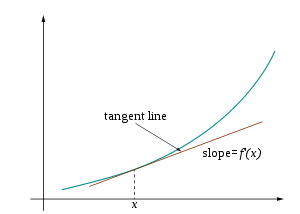In mathematics, linearization is finding the linear approximation to a function at a given point. The linear approximation of a function is the first order Taylor expansion around the point of interest. In the study of dynamical systems, linearization is a method for assessing the local stability of an equilibrium point of a system of nonlinear differential equations or discrete dynamical systems.[1] This method is used in fields such as engineering, physics, economics, and ecology.
YouTube Encyclopedic
-
1/5Views:468 072431 742149 91724 46742 449
-
Local linearization | Derivative applications | Differential Calculus | Khan Academy
-
Linear Approximation, Differentials, Tangent Line, Linearization, f(x), dy, dx - Calculus
-
Intro to Control - 5.2 System Linearization
-
Linear Approximation - Linearization with Taylor Series
-
Linearization of Differential Equations
Transcription
Linearization of a function
Linearizations of a function are lines—usually lines that can be used for purposes of calculation. Linearization is an effective method for approximating the output of a function at any based on the value and slope of the function at , given that is differentiable on (or ) and that is close to . In short, linearization approximates the output of a function near .
For example, . However, what would be a good approximation of ?
For any given function , can be approximated if it is near a known differentiable point. The most basic requisite is that , where is the linearization of at . The point-slope form of an equation forms an equation of a line, given a point and slope . The general form of this equation is: .
Using the point , becomes . Because differentiable functions are locally linear, the best slope to substitute in would be the slope of the line tangent to at .
While the concept of local linearity applies the most to points arbitrarily close to , those relatively close work relatively well for linear approximations. The slope should be, most accurately, the slope of the tangent line at .

Visually, the accompanying diagram shows the tangent line of at . At , where is any small positive or negative value, is very nearly the value of the tangent line at the point .
The final equation for the linearization of a function at is:
For , . The derivative of is , and the slope of at is .
Example
To find , we can use the fact that . The linearization of at is , because the function defines the slope of the function at . Substituting in , the linearization at 4 is . In this case , so is approximately . The true value is close to 2.00024998, so the linearization approximation has a relative error of less than 1 millionth of a percent.
Linearization of a multivariable function
The equation for the linearization of a function at a point is:
The general equation for the linearization of a multivariable function at a point is:
where is the vector of variables, is the gradient, and is the linearization point of interest .[2]
Uses of linearization
Linearization makes it possible to use tools for studying linear systems to analyze the behavior of a nonlinear function near a given point. The linearization of a function is the first order term of its Taylor expansion around the point of interest. For a system defined by the equation
- ,
the linearized system can be written as
where is the point of interest and is the -Jacobian of evaluated at .
Stability analysis
In stability analysis of autonomous systems, one can use the eigenvalues of the Jacobian matrix evaluated at a hyperbolic equilibrium point to determine the nature of that equilibrium. This is the content of the linearization theorem. For time-varying systems, the linearization requires additional justification.[3]
Microeconomics
In microeconomics, decision rules may be approximated under the state-space approach to linearization.[4] Under this approach, the Euler equations of the utility maximization problem are linearized around the stationary steady state.[4] A unique solution to the resulting system of dynamic equations then is found.[4]
Optimization
In mathematical optimization, cost functions and non-linear components within can be linearized in order to apply a linear solving method such as the Simplex algorithm. The optimized result is reached much more efficiently and is deterministic as a global optimum.
Multiphysics
In multiphysics systems—systems involving multiple physical fields that interact with one another—linearization with respect to each of the physical fields may be performed. This linearization of the system with respect to each of the fields results in a linearized monolithic equation system that can be solved using monolithic iterative solution procedures such as the Newton–Raphson method. Examples of this include MRI scanner systems which results in a system of electromagnetic, mechanical and acoustic fields.[5]
See also
- Linear stability
- Tangent stiffness matrix
- Stability derivatives
- Linearization theorem
- Taylor approximation
- Functional equation (L-function)
References
- ^ The linearization problem in complex dimension one dynamical systems at Scholarpedia
- ^ Linearization. The Johns Hopkins University. Department of Electrical and Computer Engineering Archived 2010-06-07 at the Wayback Machine
- ^ Leonov, G. A.; Kuznetsov, N. V. (2007). "Time-Varying Linearization and the Perron effects". International Journal of Bifurcation and Chaos. 17 (4): 1079–1107. Bibcode:2007IJBC...17.1079L. doi:10.1142/S0218127407017732.
- ^ a b c Moffatt, Mike. (2008) About.com State-Space Approach Economics Glossary; Terms Beginning with S. Accessed June 19, 2008.
- ^ Bagwell, S.; Ledger, P. D.; Gil, A. J.; Mallett, M.; Kruip, M. (2017). "A linearised hp–finite element framework for acousto-magneto-mechanical coupling in axisymmetric MRI scanners". International Journal for Numerical Methods in Engineering. 112 (10): 1323–1352. Bibcode:2017IJNME.112.1323B. doi:10.1002/nme.5559.





![{\displaystyle [a,b]}](https://wikimedia.org/api/rest_v1/media/math/render/svg/9c4b788fc5c637e26ee98b45f89a5c08c85f7935)
![{\displaystyle [b,a]}](https://wikimedia.org/api/rest_v1/media/math/render/svg/e3015146003c7dab01d939e34e07159fa9604bc3)







































